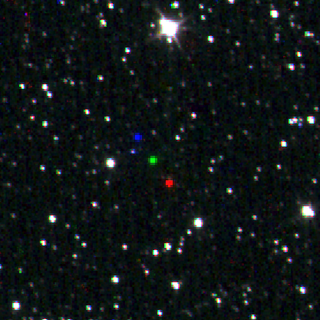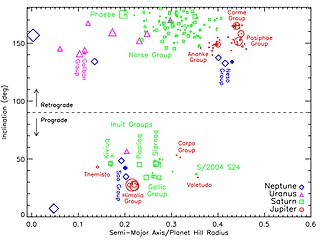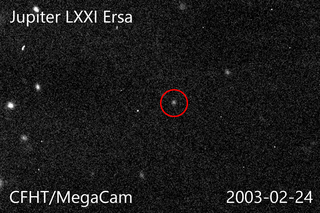Related Research Articles

A natural satellite is, in the most common usage, an astronomical body that orbits a planet, dwarf planet, or small Solar System body. Natural satellites are colloquially referred to as moons, a derivation from the Moon of Earth.

Themisto, also known as Jupiter XVIII, is a small prograde irregular satellite of Jupiter. It was discovered in 1975, subsequently lost, and rediscovered in 2000.

The moons of Saturn are numerous and diverse, ranging from tiny moonlets only tens of meters across to the enormous Titan, which is larger than the planet Mercury. There are 146 moons with confirmed orbits, the most of any planet in the solar system. This number does not include the many thousands of moonlets embedded within Saturn's dense rings, nor hundreds of possible kilometer-sized distant moons that were seen through telescopes but not recaptured. Seven Saturnian moons are large enough to have collapsed into a relaxed, ellipsoidal shape, though only one or two of those, Titan and possibly Rhea, are currently in hydrostatic equilibrium. Three moons are particularly notable. Titan is the second-largest moon in the Solar System, with a nitrogen-rich Earth-like atmosphere and a landscape featuring river networks and hydrocarbon lakes. Enceladus emits jets of ice from its south-polar region and is covered in a deep layer of snow. Iapetus has contrasting black and white hemispheres as well as an extensive ridge of equatorial mountains among the tallest in the solar system.

Siarnaq, also designated Saturn XXIX, is the second-largest irregular moon of Saturn. It was discovered on 23 September 2000 by a team of astronomers led by Brett J. Gladman. It was named after the Inuit goddess of the sea, Siarnaq, who is more commonly known as Sedna. Siarnaq is the largest member of Saturn's Inuit group of prograde irregular moons, which orbit far from Saturn in the same direction as the planet's rotation. The moons of the Inuit group are believed to have originated as fragments from the collisional breakup of a larger progenitor moon after it was gravitationally captured into orbit around Saturn several billion years ago. Several other small Inuit group moons share similar orbits to Siarnaq, indicating that the moon had experienced another collision after forming from its progenitor.
The naming of moons has been the responsibility of the International Astronomical Union's committee for Planetary System Nomenclature since 1973. That committee is known today as the Working Group for Planetary System Nomenclature (WGPSN).

The Gallic group is a dynamical grouping of the prograde irregular satellites of Saturn following similar orbits. Their semi-major axes range between 16 and 19 Gm, their inclinations between 36° and 41°, and their eccentricities between 0.46 and 0.53. The International Astronomical Union (IAU) reserves names taken from Gallic mythology for these moons.
S/2006 S 1 is a natural satellite of Saturn. Its discovery was announced by Scott S. Sheppard, David C. Jewitt, Jan Kleyna, and Brian G. Marsden on June 26, 2006 from observations taken between January 4 and April 30, 2006. S/2006 S 1 is about 6 kilometres in diameter, and orbits Saturn at an average distance of 18.65 Gm in 951.1 days, at an inclination of 154.6° to the ecliptic, in a retrograde direction and with an eccentricity of 0.0814.

In astronomy, an irregular moon, irregular satellite or irregular natural satellite is a natural satellite following a distant, inclined, and often eccentric and retrograde orbit. They have been captured by their parent planet, unlike regular satellites, which formed in orbit around them. Irregular moons have a stable orbit, unlike temporary satellites which often have similarly irregular orbits but will eventually depart. The term does not refer to shape; Triton for example, is a round moon, but is considered irregular due to its orbit.
In astronomy, an inner moon or inner natural satellite is a natural satellite following a prograde, low-inclination orbit inwards of the large satellites of the parent planet. They are generally thought to have been formed in situ at the same time as the coalescence of the original planet. Neptune's moons are an exception, as they are likely reaggregates of the pieces of the original bodies, which were disrupted after the capture of the large moon Triton. Inner satellites are distinguished from other regular satellites by their proximity to the parent planet, their short orbital periods, their low mass, small size, and irregular shapes.

Retrograde motion in astronomy is, in general, orbital or rotational motion of an object in the direction opposite the rotation of its primary, that is, the central object. It may also describe other motions such as precession or nutation of an object's rotational axis. Prograde or direct motion is more normal motion in the same direction as the primary rotates. However, "retrograde" and "prograde" can also refer to an object other than the primary if so described. The direction of rotation is determined by an inertial frame of reference, such as distant fixed stars.

Valetudo, also known as Jupiter LXII and originally known as S/2016 J 2, is an irregular moon of Jupiter. It was discovered by Scott S. Sheppard and his team in data acquired by the 6.5-m Magellan-Baade telescope of the Las Campanas Observatory in 2016, but was not announced until 17 July 2018, via a Minor Planet Electronic Circular from the Minor Planet Center, which also reported the discovery of nine other of Jupiter's moons. Besides data from Las Campanas, the original announcement also referred to data acquired through the 8.1-m Gemini North telescope of the Mauna Kea Observatories as well as the 4.0-m reflector of the Cerro Tololo Inter-American Observatory.

Ersa, also designated Jupiter LXXI, is a small outer natural satellite of Jupiter discovered by Scott S. Sheppard on 11 May 2018, using the 4.0-meter Víctor M. Blanco Telescope at Cerro Tololo Observatory, Chile. It was announced alongside nine other Jovian moons on 17 July 2018 and it provisionally designated S/2018 J 1 by the Minor Planet Center, after observations were collected over a long enough time span to confirm the satellite's orbit. The satellite has been found in precovery observations as early as 6 August 2000.

Pandia, also designated Jupiter LXV, is a small outer natural satellite of Jupiter discovered by Scott S. Sheppard on 11 May 2018, using the 4.0-meter Víctor M. Blanco Telescope at Cerro Tololo Observatory, Chile. It was announced alongside nine other Jovian moons on 17 July 2018 and it provisionally designated S/2017 J 4 by the Minor Planet Center, after observations were collected over a long enough time span to confirm the satellite's orbit. The satellite has been found in precovery observations as early as 2003.
S/2004 S 24 is a natural satellite of Saturn, and the outermost known prograde satellite. Its discovery was announced by Scott S. Sheppard, David C. Jewitt, and Jan Kleyna on October 7, 2019 from observations taken between December 12, 2004 and March 22, 2007.
S/2020 S 1 is a natural satellite of Saturn. Its discovery was announced by Scott S. Sheppard, David C. Jewitt, Jan Kleyna, Edward Ashton, Brett J. Gladman, Jean-Marc Petit and Mike Alexandersen on May 3, 2023 from observations taken between December 14, 2004 and July 8, 2021.
S/2019 S 14 is a natural satellite of Saturn. Its discovery was announced by Edward Ashton and Brett J. Gladman on May 10, 2023 from observations taken between July 1, 2019 and July 9, 2021.
S/2020 S 3 is a natural satellite of Saturn. Its discovery was announced by Edward Ashton, Brett J. Gladman, Jean-Marc Petit and Mike Alexandersen on May 5, 2023 from observations taken between July 3, 2019 and July 9, 2021.
S/2019 S 6 is a natural satellite of Saturn. Its discovery was announced by Edward Ashton and Brett J. Gladman on May 8, 2023 from observations taken between July 3, 2019 and July 8, 2021.
S/2020 S 5 is a natural satellite of Saturn. Its discovery was announced by Edward Ashton, Brett J. Gladman, Jean-Marc Petit and Mike Alexandersen on May 6, 2023 from observations taken between July 3, 2019 and July 9, 2021.
References
- 1 2 "Planetary Satellite Mean Elements". Jet Propulsion Laboratory. California Institute of Technology. Retrieved 7 May 2023.
- 1 2 "MPEC 2023-J49 : S/2006 S 12". Minor Planet Electronic Circular. Minor Planet Center. Retrieved 7 May 2023.